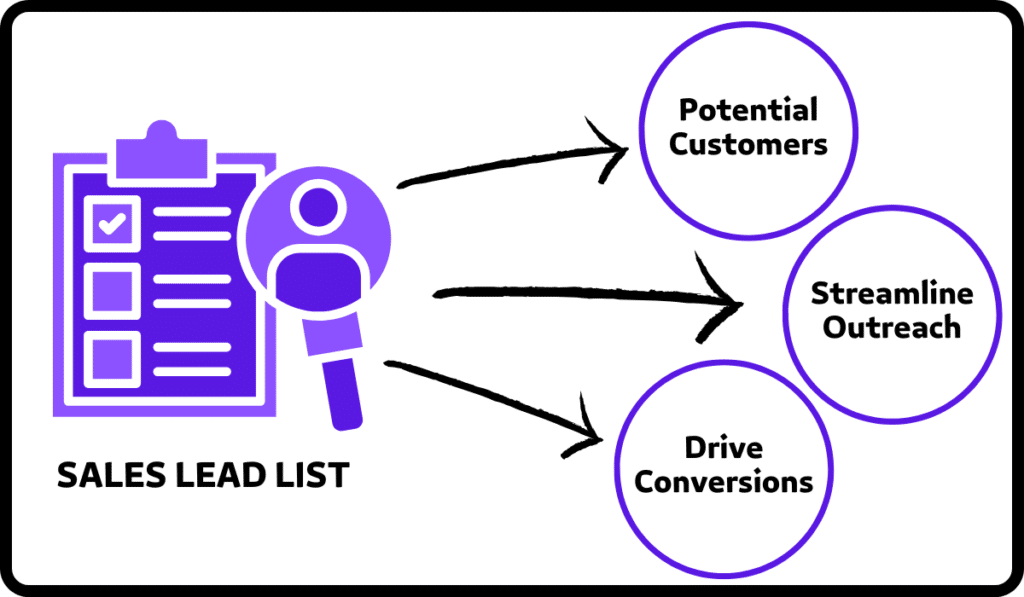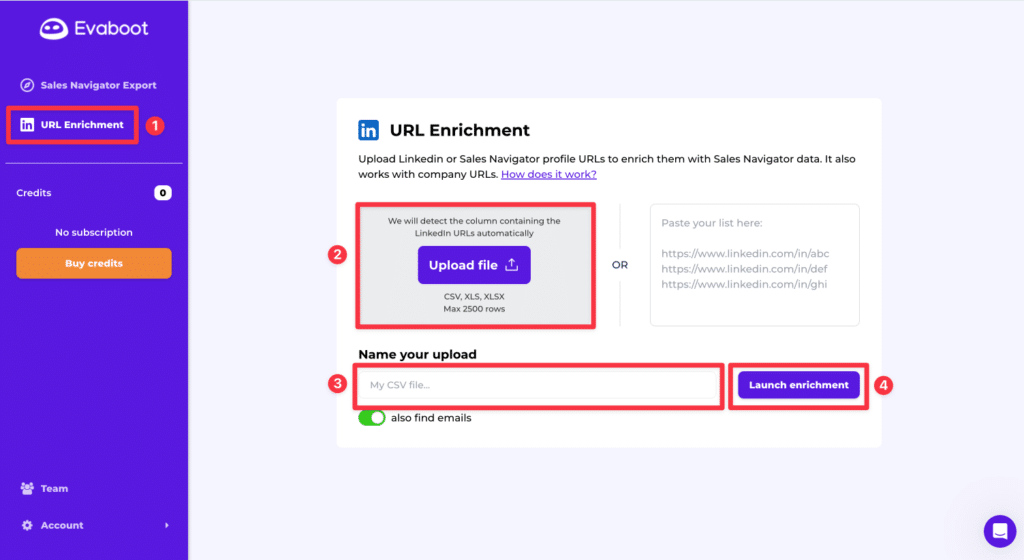Export Leads From Sales Navigator

Create a clean B2B email list from LinkedIn Sales Navigator in just one click with the Evaboot Chrome Extension.
Export Leads From Sales Navigator

Create a clean B2B email list from LinkedIn Sales Navigator in just one click with the Evaboot Chrome Extension.
Contents
In today’s competitive B2B landscape, a high-quality sales lead list can make the difference between hitting targets and falling short.
Sales teams rely on well-curated lead lists to identify potential customers, streamlinline outreach, and drive conversions.

A sales lead list is more than just contact information. It’s a strategic asset that helps your sales team focus on prospects most likely to convert.
With the right data, your salespeople can personalize their approach and build meaningful connections with decision-makers in a company.
In this comprehensive guide, we’ll explore:
Let’s get into it.
A sales lead list is a structured collection of potential customers identified as possible buyers for your product or service. These lists serve as the foundation of effective B2B sales strategies.
Unlike generic contact databases, a well-crafted sales lead list contains detailed information about each prospect, including:

Sales lead lists typically include various types of leads:

The quality of your sales lead list directly impacts your team’s efficiency.
According to recent studies, sales representatives spend only about 35% of their time actually selling. The rest is consumed by administrative tasks, research, and data entry.
With accurate data, your salespeople can focus on prospects most likely to convert.
Sales lead lists provide significant advantages for B2B sales teams:

For B2B sales teams facing aggressive targets, sales lead lists provide the foundation for predictable, scalable growth through systematic processes for identifying and converting qualified leads.
An effective lead list goes beyond just names and emails. It includes a combination of the following data points:
Accurate contact information forms the foundation of any sales lead list:

Without reliable contact information, even the best lead list won’t deliver results.
Comprehensive firmographic data provides crucial context:

For B2B sales, company size often correlates with budget availability and specific pain points. This information allows for more targeted outreach.
Geographic information remains relevant even in our increasingly remote world. Local regulations, market conditions, and business cultures can significantly impact a prospect’s needs and decision-making process.
Targeting the right stakeholders is essential:

In complex B2B sales, multiple decision-makers are often involved in the purchasing process.
Your lead list should identify key roles such as end-users, technical evaluators, financial approvers, and ultimate decision-makers.
Effective segmentation enables personalized communication:

Segmentation tags might identify prospects by industry vertical, company maturity stage, technology stack, or specific pain points they’re likely experiencing.
Not all leads deserve equal attention:

Modern CRM systems like HubSpot and Salesforce offer sophisticated lead scoring capabilities that can be integrated with your lead list.
These tools can automatically update scores based on new interactions, ensuring your sales team always has current information when deciding which prospects to contact next.
Here is how to build a sales lead list in 5 easy steps:
Let’s dive into each step in detail.
The first step to building a lead list is to discover and define your ideal customer profile (ICP) and buyer persona.
An ICP describes the type of company that fits the best to your product or service.
A buyer persona is a semi-fictional representation of the individual decision-makers within your target companies.

By creating an ICP and buyer personas, you can narrow down your target market and focus on your business’s most relevant and qualified prospects.
To create an ICP, you need to consider factors and demographics such as:

To create a buyer persona, you need to consider factors such as:

You can easily create buyer personas with online tools like HubSpot’s Make My Persona or Xtensio’s User Persona Creator.
You can also use surveys, interviews, or social media to gather prospect data and insights from your existing customers or contact lists.

To complete these steps, you must clearly understand what you are trying to sell.
As a salesperson, you must grasp:
Understanding your unique value proposition lets you identify which customers will benefit from your product or service.
LinkedIn Sales Navigator is a powerful tool for salespeople to quickly and easily identify and connect with potential customers.
With Sales Navigator, sales reps can access an extensive database of prospects and leads, including detailed information about their job titles, company size, industry, and more.

The first step will be to build a list of companies matching your Ideal Customer profile.
For that, you can use the account search filters:
You can find other filters to find the companies that would be perfect clients for your business.

It’s time to save all these companies into a list:

Now, let’s find your buyer personas in these ICP companies.
All the people working in these companies will appear on the right.

Obviously, we don’t want to reach out to everybody.
We must find our buyer persona inside that list.
For that, we are going to use lead filters like:

Here, I added “CEO” to the job title filter, and LinkedIn gave me all the CEOs of the companies on my list.
This is an easy and efficient way to identify the right buyer persona inside ICP companies quickly.

Once you are happy with a search, you can even save it. LinkedIn will alert new leads matching your search criteria every week.
Tip: You can create a Persona in Sales Navigator by function, seniority, job title, and geography to quickly find the right leads and stop wasting time rebuilding searches.
Now that you have a list of qualified prospects, the next step is to export the data with a LinkedIn scraping tool.
To export your leads from LinkedIn Sales Navigator to a CSV file, you can use the Evaboot Chrome Extension.
You can see a demo of the tool here:
Once installed, the Chrome Extension will add a new button on your Sales Navigator.

This button will allow you to export up to 2500 leads per day from LinkedIn Sales Navigator with all the data on their profiles on company pages:

Evaboot is also a great tool for:
Once you export the lead list into a CSV file, you can click on “Find emails” to find the professional emails of your prospects.

Evaboot will also verify these emails so you can control your bounce rate and protect your email reputation.
Here is what the file will look like:

Safe means that we are 99% sure that the email exists.
Riskier shows that the company’s email server is a catch-all, so we can’t say if the email exists.
If you also want phone numbers, you can use Evaboot with Datagma.
That being said, lead data is not static.
B2B data decays by 2.1% per month, meaning 22.5% of your exported leads could be outdated within a year. Job titles change, companies evolve, and outdated information leads to wasted outreach efforts.
To solve this, Evaboot offers URL Enrichment: a tool allowing you to upload Linkedin URLs stored in your CRM to enrich your LinkedIn contacts with Sales Navigator data.
How it works:


And here you go!
We recommend updating your lead lists every 3-6 months to maintain accuracy. This ensures your database stays fresh, relevant, and effective—so your sales efforts never go to waste.
For a visual step-by-step guide, check out the video tutorial:
You got leads. You got emails.
Now you have to import your enriched lead list to your CRM:
For that, you can use a CRM line such as Pipedrive, Hubspot or Salesforce.
Pipedrive is a good fit if you are just getting started.
If you are a small marketing team you can go with Hubspot.
If you are an enterprise with a really big sales team, you can go with Salesforce.

Once your leads are uploaded into your CRM, you can start doing manual outreach to these leads and keep track of your interactions with them by taking notes.
If you want to save time, you can also use email and LinkedIn automation tools like:
They allow you to automate email and LinkedIn messages and follow-ups so you can focus on building relationships with people who replied to you.

Since your lead list has LinkedIn profiles and emails, use both channels to contact your prospects.
Here is a video showing how to use LaGrowthMachine to reach your prospects.
Multichannel outreach will increase your chances of reaching out to your new prospects in all possible ways.
Once you’ve built a strong lead list, the next step is activating it through a strategic sales outreach.
Here are several proven tactics to engage prospects across multiple channels and move them through your sales funnel:
Make each recipient feel your message was crafted specifically for them:

Email remains a cornerstone of B2B outreach. To stand out in crowded inboxes, your messages need to feel personal and relevant from the very first touchpoint.
Approach calls strategically using lead list data:

When done right, cold calling can be highly effective. Especially when guided by insights from your lead list to make every conversation count.
Build relationships before pitching:

LinkedIn offers a more relational and less intrusive channel. It’s ideal for building trust before making a pitch, especially with executive-level contacts.
Reinforce direct outreach with targeted advertising:

Not every lead converts through direct contact alone. Targeted ads help reinforce your message and keep your brand top-of-mind throughout the buyer journey.
A high-quality sales lead list is essential for B2B sales success.
By following the strategies in this guide, you can create a lead list that drives targeted outreach, higher conversion rates, and more efficient resource allocation.
With tools like Evaboot streamlining lead list building and verification, your sales team can focus on what they do best: connecting with prospects and closing deals.
Ready to transform your sales process? Start implementing these strategies today and watch your lead list become one of your organization’s most valuable assets.
A sales lead list is a structured collection of potential customers with detailed information that helps salespeople personalize outreach and address specific business challenges.
The process involves:
Focus on: